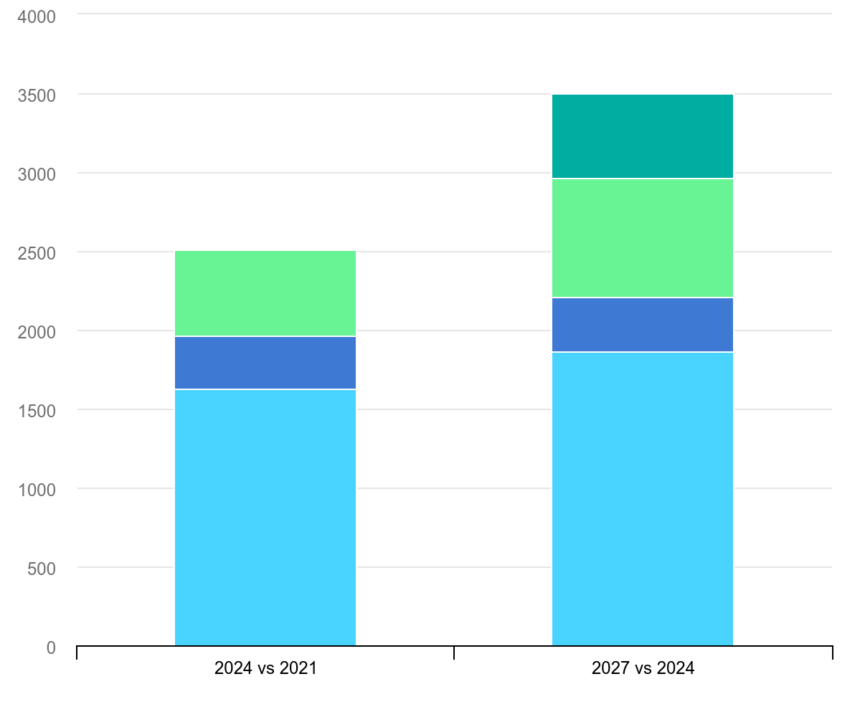
By Anders Lorenzen
The world’s thirst for electricity is growing ever more significantly and is forecast to rise at a growth rate of 4% for the next three years.
This is the conclusion of a recent International Energy Agency (IEA) analysis.
In its report, Electricity 2025, released this month, the agency forecasts that global demand will be equivalent to adding an amount greater than the annual electricity consumption in Japan every year between now and 2027. This surge is primarily driven by industrial electricity demand, the increased need for air conditioning, accelerating electrification led by the transport sector, and the rapid expansion of data centres.
The growth in demand over the next three years will primarily come from emerging and developing economies – accounting for 85% of the growth trend. This growth is being led by China, whose electricity demand has grown faster than the overall economy since 2020.

In 2024, China’s electricity consumption rose by 7% and is expected to grow by an average of around 6% through 2027. The demand in China is partly fuelled by the industrial sector alongside individual consumption habits such as air conditioning, electric vehicle adoption and other behaviours linked to data centres and 5G networks.
Unevenly distributed electricity demands
IEA Director of Energy Markets and Security, Keisuke Sadamori, said, “The acceleration of global electricity demand highlights the significant changes in energy systems worldwide and the approach of a new Age of Electricity. But it also presents evolving challenges for governments in ensuring secure, affordable and sustainable electricity supply.” He revealed the trend: “While emerging and developing economies are set to drive the large majority of the growth in global electricity demand in the coming years, consumption is also expected to increase in many advanced economies after a period of relative stagnation.”
In the US, a substantial increase in electricity demand is expected to add the equivalent of California‘s current power consumption, the largest US economy, spread over the next three years.
However, analysts expect the demand growth in the European Union (EU) will be more modest, returning to its 2021 levels by 2027.
IEA report outlining what is driving the demand?
While there’s a host of different reasons for the growth in electricity demand, the key pillars of growth are:
- The growth in industrial electricity demand
- Increased air conditioning use
- The electrification of transport such as electric vehicles
- The rapid expansion of data centres due to AI, and other internet-related activities
Low-carbon sources will dominate
In line with the overall demand growth, the Paris-based organisation EIA forecasts that the growth in low-emissions electricity sources, primarily renewables and nuclear, is sufficient to cover all growth in global electricity demand over the next three years.
This will mean that the emissions will not increase. However, they would not have reduced as much had this extraordinary growth not occurred. One technology alone, solar PV – is expected to meet roughly half of global electricity demand growth through 2027, partly due to continued cost reductions and favourable policies.
Solar PV boost
In 2024, solar PV surpassed coal in the EU, which now accounts for 10% of the electricity mix in the bloc, comprised of 27 countries. China and the US are expected to reach 10% by 2027.
In another low-carbon boost, nuclear power is making a strong comeback, with electricity generation on course to hit new highs every year from 2025 onward over the three-year forecast period.
Emissions to plateau in 2025
The IEA says that due to these trends, CO2 emissions from global electricity production are expected to plateau in the coming years after they increased by 1% in 2024.
The report also analysed the significant strains that electricity systems face across the globe with climate-induced extreme weather events.
The recent destructive winter storms in the US, the Atlantic hurricanes causing blackouts, and droughts impacting hydropower production in Ecuador, Colombia and Mexico all highlight the importance of ensuring a greater resilience of electricity systems. Related to this, the role of weather events in the rising volatility in electricity pricing systems also reflects the need for system flexibility.
Anders Lorenzen is the founding Editor of A greener life, a greener world.
Discover more from A greener life, a greener world
Subscribe to get the latest posts sent to your email.







